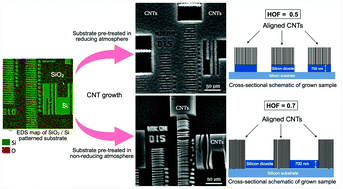Surface passivation dictated site-selective growth of aligned carbon nanotubes†
Abstract
Surface defects play a significant role in the nucleation and growth of metal particles. Site-selective nucleation of metal catalyst particles, and the subsequent growth of nanostructures, could thus be accomplished by defect engineering. This paper demonstrates the switching of growth sites of vertically aligned multiwall carbon nanotubes (MW-CNTs) by manipulation of surface passivation of the substrate and discusses the possible mechanism behind this selectivity. A complementary growth pattern of CNTs is observed for pre-treatment of identically patterned SiO2/Si substrates under a reducing and non-reducing atmosphere. Variation in the number density of oxygen vacancies on the silicon dioxide surface and the presence of native oxide on the silicon face are believed to dictate the observed selectivity. The CNT architectures mimic the substrate pattern meticulously, exhibiting sharp edges, illustrating a high degree of site selectivity. The chemical state of the substrate surface and catalyst particles has been studied using Auger electron spectroscopy. Electron microscopy and Raman spectroscopy were employed to characterize the synthesized CNTs. The Hermans orientation factor was calculated to quantify the degree of alignment of the MWCNTs. Such facile control over the growth site of aligned carbon nanotubes on a substrate is a desirable aspect of synthesis for easy integration with existing silicon fabrication technology.



 Please wait while we load your content...
Please wait while we load your content...